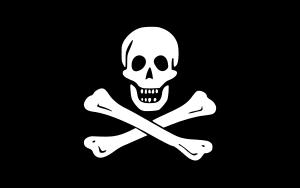This article may be too long to read and navigate comfortably. When this tag was added, its readable prose size was 15,000 words. (September 2024) |

Piracy is an act of robbery or criminal violence by ship or boat-borne attackers upon another ship or a coastal area, typically with the goal of stealing cargo and other valuable goods. Those who conduct acts of piracy are called pirates, and vessels used for piracy are called pirate ships. The earliest documented instances of piracy were in the 14th century BC, when the Sea Peoples, a group of ocean raiders, attacked the ships of the Aegean and Mediterranean civilisations. Narrow channels which funnel shipping into predictable routes have long created opportunities for piracy,[1] as well as for privateering and commerce raiding.
Historic examples of such areas include the waters of Gibraltar, the Strait of Malacca, Madagascar, the Gulf of Aden, and the English Channel, whose geographic structures facilitated pirate attacks.[2][3] The term piracy generally refers to maritime piracy, although the term has been generalized to refer to acts committed on land,[4] in the air, on computer networks, and (in science fiction) outer space. Piracy usually excludes crimes committed by the perpetrator on their own vessel (e.g. theft), as well as privateering, which implies authorization by a state government.
Piracy or pirating is the name of a specific crime under customary international law and also the name of a number of crimes under the municipal law of a number of states. In the 21st century, seaborne piracy against transport vessels remains a significant issue, with estimated worldwide losses of US$25 billion in 2023,[5] increased from US$16 billion in 2004.[6]
The waters between the Red Sea and the Indian Ocean, off the Somali coast and in the Strait of Malacca and Singapore have frequently been targeted by modern pirates armed with automatic weapons, such as assault rifles, and machine guns, grenades and rocket propelled grenades. They often use small motorboats to attack and board ships, a tactic that takes advantage of the small number of crew members on modern cargo vessels and transport ships. The international community is facing many challenges in bringing modern pirates to justice, as these attacks often occur in international waters.[7] Nations have used their naval forces to repel and pursue pirates, and some private vessels use armed security guards, high-pressure water cannons, or sound cannons to repel boarders, and use radar to avoid potential threats.
Romanticised accounts of piracy during the Age of Sail have long been a part of Western pop culture. The two-volume A General History of the Pyrates, published in London in 1724, is generally credited with bringing key piratical figures and a semi-accurate description of their milieu in the "Golden Age of Piracy" to the public's imagination. The General History inspired and informed many later fictional depictions of piracy, most notably the novels Treasure Island (1883) and Peter Pan (1911), both of which have been adapted and readapted for stage, film, television, and other media across over a century. More recently, pirates of the "golden age" were further stereotyped and popularized by the Pirates of the Caribbean film franchise, which began in 2003.
- ^ Pennell, C. R. (2001). "The Geography of Piracy: Northern Morocco in the Mod-Nineteenth Century". In Pennell, C. R. (ed.). Bandits at Sea: A Pirates Reader. NYU Press. p. 56. ISBN 978-0-8147-6678-1.
Sea raiders [...] were most active where the maritime environment gave them most opportunity. Narrow straits which funneled shipping into places where ambush was easy, and escape less chancy, called the pirates into certain areas.
- ^ Heebøll-Holm, Thomas (2013). Ports, Piracy and Maritime War: Piracy in the English Channel and the Atlantic, c. 1280–c. 1330. Medieval Law and Its Practice. Leiden: Brill. p. 67. ISBN 978-9004248168.
[...] through their extensive piracies the Portsmen [of the Cinque Ports] were experts in predatory actions at sea. [...] Furthermore, the geostrategic location of the [Cinque] Ports on the English coast closest to the Continent meant that the Ports [...] could effectively control the Narrow Seas.
- ^ "TEDx Talk: What is Piracy?". Archived from the original on June 18, 2020. Retrieved October 23, 2014.
- ^ Arquilla, John (2011). Insurgents, Raiders, and Bandits: How Masters of Irregular Warfare Have Shaped Our World. Ivan R. Dee. p. 242. ISBN 978-1-56663-908-8. Archived from the original on January 12, 2023. Retrieved March 5, 2015.
From ancient high seas pirates to 'road agents' and a host of other bush and mountain pass brigands, bandits have been with us for ages.
- ^ He, Zhaoyang; Wang, Chengjin; Gao, Jianbo; Xie, Yongshun (October 14, 2023). "Assessment of global shipping risk caused by maritime piracy". Heliyon. 9 (10): e20988. Bibcode:2023Heliy...920988H. doi:10.1016/j.heliyon.2023.e20988. ISSN 2405-8440. PMC 10616333. PMID 37916124.
- ^ "Terrorism Goes to Sea". Foreign Affairs. Archived from the original on December 14, 2007. Retrieved December 8, 2007.
- ^ D.Archibugi, M.Chiarugi (April 9, 2009). "Piracy challenges global governance". openDemocracy. Archived from the original on April 12, 2009. Retrieved April 9, 2009.